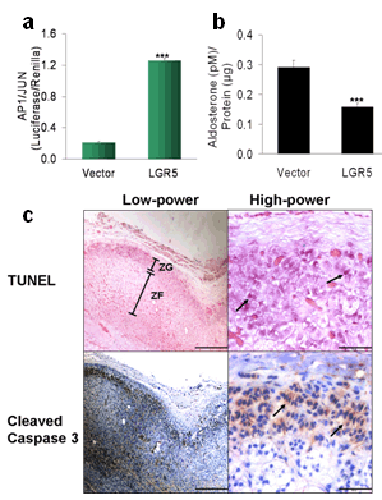Print version
Search Pub Med
LGR5 expression in human adrenal activates non-canonical WNT-signaling, and reduces aldosterone secretion and cell number Background: Zona glomerulosa (ZG)-like aldosterone-producing adenomas, with common somatic mutations in CACNA1D or ATP1A1, may be a consequence of high turnover of adrenocortical cells (1). We aimed to compare by microarray the transcriptomes of ZG vs zona fasciculata (ZF) and to examine effects on aldosterone production of up-regulated genes in the Wnt signalling pathway. Methods: RNA from ZG and ZF of 20 human adrenals with adjacent tumours was analysed
Results: LGR5, a Wnt signaling target and stem cell marker, was the most up-regulated gene in ZG (x25, P=10-23) vs. paired ZF. Immunohistochemistry confirmed localisation of LGR5 in ZG. Over transfection of LGR5 caused inhibition of aldosterone secretion (Fig 1b). Wnt AP1/JUN signalling showed a 5.7 fold increase in LGR5 transfected cells (Fig 1a). Staining of Wnt AP1/JUN pathway genes and apoptosis markers (TUNEL and Cleaved Caspase 3) also localised to the ZG (Fig 1c). FACS separation of H295R cells positive for Annexin V showed 54.3±3.3% apoptosis in LGR5-transfected vs 34.4±2.5% in vector-transfected cells. Incucyte live cell imagining over 90hrs further supported reduction in proliferation in LGR5 transfected cells (n=6), P=1.5x10-5. Fig 1 (a) AP-1/Jun non-canonical Wnt activity (vector, LGR5 transfected), by estimating activity of a luciferase construct with a AP1-responsive promoter (b) and corresponding aldosterone secretion (n=5), ***P<0.001. (c) Bright-field microscopy showing staining for TUNEL and Cleaved Caspase 3 (apoptosis markers, dark purple and brown) (n=6). Scale bar= 500um and 50um. Conclusion: LGR5 is the most ZG-selective gene in human adrenal. Our results suggest that LGR5 switches non-canonical Wnt signaling, and that this results in cell loss and inhibition of aldosterone production. The switch may be a protective response to high salt intake, and is reversed by some of the somatic mutations causing constitutive production of aldosterone in adrenal adenomas. 1. Azizan et al., Nat Genet 2013; 45(9):1055-106
|


